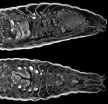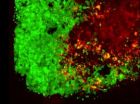(Press-News.org) New animal studies by Johns Hopkins cardiovascular researchers strongly suggest that sildenafil, the erectile dysfunction drug sold as Viagra and now under consideration as a treatment for heart failure, affects males and females very differently.
The results of their investigations in varied male and female mouse models of heart failure are so clear-cut, says lead scientist Eiki Takimoto, M.D., Ph.D., that physicians may need to take gender into consideration when prescribing certain medications and that drug developers would be wise to take them into careful account when setting protocols for clinical trials of the medication in people. An online description of the new research appears May 16 in The Journal of Clinical Investigation.
Specifically, in female mice modeling human heart failure, the benefits of sildenafil ranged from robust to practically nonexistent, depending on the animals' levels of the hormone estrogen, says Takimoto, an assistant professor of medicine and a researcher with the Heart and Vascular Institute at Johns Hopkins. In male mice, sildenafil generally appears to work well, but only because it targets a different biological process independent of estrogen, he says. Estrogen is present in both male and female mammals, although in different amounts.
"The research is especially significant," he adds, "because it offers a mechanism to explain how estrogen affects sildenafil's efficacy. That's the first time the actual pathway of a hormone's cause and effect on a drug has been mapped out."
Sildenafil, the generic compound used to initiate and strengthen male erections, works by encouraging blood vessels to dilate and increase blood flow to the penis. The effects are similar to some drugs, such as nitrates, already used to increase blood flow to failing hearts. Besides these effects, beneficial direct effects on heart muscles have been suggested by recent experimental studies, which is why researchers believe it could help patients with heart failure.
Heart failure is the most common reason for hospital admissions in the Medicare population, according to heart experts, and is the leading cause of death in Americans. Useful drugs such as beta-blockers and ACE inhibitors help to increase the blood-pumping efficiency of the heart, "yet they don't fully address the ongoing pathology," says Takimoto.
Whether due to a heart attack, hypertension, arteriosclerosis or other reasons, even moderate injury to heart muscle cells can initiate a downhill remodeling of broad areas of heart tissue, including enlargement of the heart and stiffening of heart chambers as fibrous proteins replace more flexible ones in muscle cells. The weakened and altered heart muscle compromises circulation, a hallmark of heart failure.
"Because cardiac remodeling is an underlying mechanism," Takimoto says, "we've put more than a decade of research into understanding it enough to stop or reverse it."
Key to the Johns Hopkins team's research, Takimoto says, is the molecule cyclic guanosine monophosphate (cGMP), which trips a helpful biochemical cascade that can counter effects of hypertension and other stressors. Heart cells typically maintain a strategic pool of cGMP, but heart-damaging events deplete this pool via the disabling action of an enzyme called PDE5. That's where sildenafil comes in.
As a potent inhibitor of PDE5, sildenafil increases cell levels of cGMP, which helps erectile dysfunction. More recently, research has explored the drug's ability to raise cGMP levels for cardiac disease.
In 2005, Takimoto's group studied sildenafil in mice engineered to have so-called transverse aortic constriction (TAC). A surgically-fitted band around the aorta in mice with TAC raised their internal heart pressure.
The result was cardiac remodeling, and then signs of classic human heart failure. "By increasing cGMP with sildenafil, we both blocked and reversed remodeling in the animals, ameliorating heart failure," Takimoto says.
Subsequent work by other research groups with various animal models showed similar effects, laying groundwork for human heart disease studies.
The new gender-based findings are especially interesting, Takimoto says, because of contradictory results of early clinical trials with sildenafil for heart failure. Notably, he says, a small, single-center clinical study showed sildenafil's long-term positive effects against cardiac remodeling and classic human heart failure. But last year, results of the RELAX study — a National Institutes of Health-sponsored, 26-center U.S. and Canadian study testing sildenafil against placebo for diastolic heart failure, a difficult-to-treat type of heart failure — found essentially no benefit.
To better understand the protective effects of cGMP activity, Takimoto's team focused on the tie-in with estrogen, also known to be naturally cardioprotective. Women, for example, develop heart disease much later on average than men, usually after menopause and estrogen depletion; estrogen feeds into the cGMP pathway. But this new study by Takimoto's group used sildenafil to shed more light on the process.
The team used both the TAC model and an established, powerful, gene-based model of heart failure that together better reflected human heart failure, according to Takimoto. Half of the female mice his team tested had their ovaries removed, which meant these mice had minimal levels of estrogen. Both groups of female mice received sildenafil. As expected, all the mice developed cardiac remodeling, but those low in estrogen fared far worse. Treating the estrogen-low mice with supplements of the hormone, however, raised cGMP and reversed heart damage. "This tells us that estrogen critically impacts the response to sildenafil in heart failure treatment," Takimoto says.
Male mice, which have naturally low amounts of estrogen, fared differently. Like the females, they had cardiac remodeling. But sildenafil alone was able to stop it.
Takimoto explains the gender effect as a difference in male-female physiology: "In female mice, their normally high estrogen levels insure presence of an ongoing pool of cGMP with its protective effects. In males, however, there's no such pool of cGMP. It's synthesized only in response to stress on the heart."
"Our findings may have important clinical implications," he and study first author Hideyuki Sasaki, M.D., Ph.D., say. They cite the RELAX trial, where half of the participants were 69 or older. That's long after menopause started for women in the trials. "Knowing that sildenafil's benefits to female mice come only with higher estrogen levels offers a possible reason for RELAX's negative results," says Takimoto.
That and the ability of added estrogen to turn around a poor sildenafil response in the mice, he adds, "suggest we need to look more into female-specific strategies with these therapies."
INFORMATION:
Other Johns Hopkins researchers involved in the research include David A. Kass, M.D.; Kinya Seo, Ph.D.; Manling Zhang, M.D.; Guangshuo Zhu, M.D.; Dong I. Lee, Ph.D.; Djahida Bedja, M.S.; and Steven Hsu, M.D. Researchers from Tufts University, Osaka University, the National Cerebral and Cardiovascular Center in Osaka and the Mendelsohn Consulting Group in Boston also contributed.
This work was supported by the National Institutes of Health's National Heart, Blood and Lung Institute (HL-093432 and HL-089297), the American Heart Association, the Japan Heart Foundation/Bayer Yakuhin Research Grant Abroad, the Muscular Dystrophy Association, Fondation Leducq, and the Abraham and Virginia Weiss Endowment.
Johns Hopkins Medicine (JHM), headquartered in Baltimore, Maryland, is a $6.7 billion integrated global health enterprise and one of the leading health care systems in the United States. JHM unites physicians and scientists of the Johns Hopkins University School of Medicine with the organizations, health professionals and facilities of The Johns Hopkins Hospital and Health System. JHM's vision, "Together, we will deliver the promise of medicine," is supported by its mission to improve the health of the community and the world by setting the standard of excellence in medical education, research and clinical care. Diverse and inclusive, JHM educates medical students, scientists, health care professionals and the public; conducts biomedical research; and provides patient-centered medicine to prevent, diagnose and treat human illness. JHM operates six academic and community hospitals, four suburban health care and surgery centers, and more than 30 primary health care outpatient sites. The Johns Hopkins Hospital, opened in 1889, was ranked number one in the nation for 21 years in a row by U.S. News & World Report.
Johns Hopkins Medicine, 901 South Bond St., Suite 550, Baltimore, MD 21231 United States
Gender differences stand out in measuring impact of Viagra as therapy for heart failure
2014-05-17
ELSE PRESS RELEASES FROM THIS DATE:
The early earthworm catches on to full data release
2014-05-17
To quote the American cartoonist Gary Larson: all things play a role in nature, even the lowly worm—but perhaps never in such a visually stunning way as that presented in two papers published today in the open access journals GigaScience and PLOS ONE. The work and data presented here provide the first-ever comparative study of earthworm morphology and anatomy using a 3D non-invasive imaging technique called micro-computed tomography (or microCT), which digitizes worm structures. This opens the possibility of scanning millions of specimens from museum collections, including ...
JCI online ahead of print table of contents for May 16, 2014
2014-05-16
Targeting microbial translocation attenuates SIV-mediated inflammation
Patients with HIV often present with signs of immune activation and systemic inflammation, both of which are hypothesized to directly contribute to the development of AIDs in infected individuals. HIV and the related simian immunodeficiency virus (SIV) damage the gut mucosa, leading to translocation of microbes from the intestinal lumen to the general circulation, but it is not clear if microbial translocation is directly responsible for chronic HIV-associated inflammation. In this issue of the Journal ...
Methadone programs can be key in educating, treating HCV patients
2014-05-16
BUFFALO, N.Y. – People who inject drugs and are enrolled in a drug treatment program are receptive to education about, and treatment for, hepatitis C virus, according to a study by researchers at several institutions, including the University at Buffalo.
That finding, published online this week in the Journal of Addiction Medicine will be welcome news to health care providers. The paper notes that injection drug use is a primary mode of infection, making for an HCV infection prevalence as high as 80 percent among people who inject drugs.
"One of the most important findings ...
Non-invasive lithotripsy leads to more treatment for kidney stones
2014-05-16
DURHAM, N.C. – When it comes to treating kidney stones, less invasive may not always be better, according to new research from Duke Medicine.
In a direct comparison of shock wave lithotripsy vs. ureteroscopy – the two predominant methods of removing kidney stones – researchers found that ureteroscopy resulted in fewer repeat treatments.
The findings were published May 16, 2014, in the journal JAMA Surgery, coinciding with presentation at the annual meeting of the American Urological Association.
"Nearly one out of 11 people in the United States has kidney stones, ...
Cognitive behavioral or relaxation training helps women reduce distress during breast cancer treatment
2014-05-16
Coral Gables, Fla. (May 16, 2014) – Can psychological intervention help women adapt to the stresses of breast cancer? It appears that a brief, five-week psychological intervention can have beneficial effects for women who are dealing with the stresses of breast cancer diagnosis and surgery. Intervening during this early period after surgery may reduce women's distress and providing cognitive or relaxation skills for stress management to help them adapt to treatment.
Researchers at the University of Miami recruited 183 breast cancer patients from surgical oncology clinics ...
Spiders spin possible solution to 'sticky' problems
2014-05-16
Researchers at The University of Akron are again spinning inspiration from spider silk—this time to create more efficient and stronger commercial and biomedical adhesives that could, for example, potentially attach tendons to bones or bind fractures.
The Akron scientists created synthetic duplicates of the super-sticky, silk "attachment discs" that spiders use to attach their webs to surfaces. These discs are created when spiders pin down an underlying thread of silk with additional threads, like stiches or staples, explains Ali Dhinojwala, UA's H. A. Morton professor ...
With imprecise chips to the artificial brain
2014-05-16
This news release is available in German. Which circuits and chips are suitable for building artificial brains using the least possible amount of power? This is the question that Junior Professor Dr. Elisabetta Chicca from the Center of Excellence Cognitive Interaction Technology (CITEC) has been investigating in collaboration with colleagues from Italy and Switzerland.
Their surprising finding: Constructions that use not only digital but also analog compact and imprecise circuits are more suitable for building artificial nervous systems, rather than arrangements ...
Lighting the way to graphene-based devices
2014-05-16
Graphene continues to reign as the next potential superstar material for the electronics industry, a slimmer, stronger and much faster electron conductor than silicon. With no natural energy band-gap, however, graphene's superfast conductance can't be switched off, a serious drawback for transistors and other electronic devices. Various techniques have been deployed to overcome this problem with one of the most promising being the integration of ultrathin layers of graphene and boron nitride into two-dimensional heterostructures. As conductors, these bilayered hybrids ...
Herpes-loaded stem cells used to kill brain tumors
2014-05-16
Harvard Stem Cell Institute (HSCI) scientists at Massachusetts General Hospital have a potential solution for how to more effectively kill tumor cells using cancer-killing viruses. The investigators report that trapping virus-loaded stem cells in a gel and applying them to tumors significantly improved survival in mice with glioblastoma multiforme, the most common brain tumor in human adults and also the most difficult to treat.
The work, led by Khalid Shah, MS, PhD, an HSCI Principal Faculty member, is published in the Journal of the National Cancer Institute. Shah heads ...
Ataluren Phase 3 trial results in nonsense mutation cystic fibrosis
2014-05-16
SOUTH PLAINFIELD, NJ – May 16, 2014 – PTC Therapeutics, Inc. (NASDAQ: PTCT) today announced that the results of a Phase 3 study of ataluren in patients with nonsense mutation cystic fibrosis (nmCF) were published in Lancet Respiratory Medicine. The results demonstrated positive trends in both the primary endpoint, lung function as measured by relative change in % predicted FEV1 (forced expiratory volume in one second) and in the secondary outcome measure, rate of pulmonary exacerbations. The collective data from this trial, including retrospective and subgroup analyses ...





